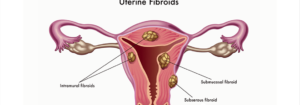 Many women adapt their lifestyle and learn to live with the pain and discomfort of uterine fibroids, allowing this condition to control their activity level and what they love to do. Fortunately, advances in interventional radiology have made treating uterine fibroids a safe and relatively painless process that empowers women to feel better all month, every month!
Many women adapt their lifestyle and learn to live with the pain and discomfort of uterine fibroids, allowing this condition to control their activity level and what they love to do. Fortunately, advances in interventional radiology have made treating uterine fibroids a safe and relatively painless process that empowers women to feel better all month, every month!
What are uterine fibroids?
Uterine fibroids are benign collections of uterine tissue that tend to get gnarled up in a ball, making them very densely packed, firm and vascular (meaning they contain blood vessels). They draw a lot of blood into the uterus with nutrients that make them grow.
Most women will develop fibroids. Some exist silently or result in minimal discomfort, but unfortunately many women have those that cause significant symptoms. They tend to be hereditary, so if your mother had fibroids you are at an increased risk of having fibroids as well. The good news is that advances in fibroid treatment can make sure you don’t have to suffer like your mother did.
What are the symptoms?
The symptoms are very noticeable, and are divided to two different categories. One symptom is heavy bleeding at the time of a woman’s period and bleeding in between periods. The second category of symptoms is related to the bathroom and the bedroom. As the fibroids grow they take up space and put pressure on the bladder resulting in a greater frequency and urge to urinate. They can also cause painful bowel movements, back pain and discomfort during intercourse.
“Whether it’s embarrassment or simply believing it’s something they just need to live with, women tend to struggle with the symptoms associated with uterine fibroids,” said Dr. Stacey Bass, M.D., Ph.D., Radiologist for Griffin Hospital and Jefferson Radiology. “But they don’t need to let fibroids take control of their lives anymore. The minimally-invasive technology of interventional radiology provides a solution called Uterine Fibroid Embolization that can treat all of your fibroids at once with a quick recovery period lasting about a week.”
How are they diagnosed?
Fibroids are usually diagnosed with a simple ultrasound. This is commonly followed by an MRI to evaluate their size, location and shape, so the physician can make a fibroid treatment plan. Both of these procedures are non-invasive and safe.
How are they treated?
Many women avoid fibroid treatment because they believe they will need a hysterectomy, but the minimally-invasive Uterine Fibroid Embolization is proven to give patients great relief and get them home the same day. This outpatient procedure includes medication to get the patient relaxed and comfortable. A small catheter about the size of pencil tip is introduced into an artery in the upper thigh. Under X-ray guidance, a small catheter is passed into the arteries supplying the fibroids. The arteries are blocked with small particles. This restricts the blood flow to fibroids and kills them by cutting off their lifeline. The procedure takes about an hour to perform. Once the procedure is completed, the catheter is removed and patients then relax in the recovery room for about five hours before going home with medicines to help in their recovery.
Back on your feet in no time
One of the main advantages of Uterine Fibroid Embolization is that recovery is relatively quick compared to invasive measures, like a hysterectomy. Complications are rare, but there can be pain as a result of the procedure and bruising near the groin, which goes away within a week or two after the procedure.
“We send you home with medication to help you through any pain,” Dr. Bass said. “We’ll contact you the next day to review your medication and answer any questions. We’ll schedule follow up visits at one month, six months, one year and two years. Most patients are pain-free and back to work within a few days.”
To discuss your fibroid treatment options or to schedule an appointment, call 203-732-7358.